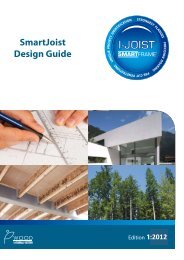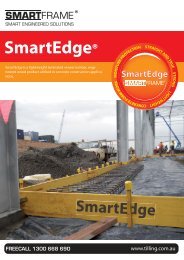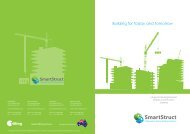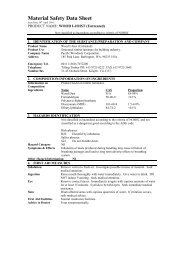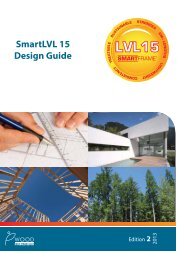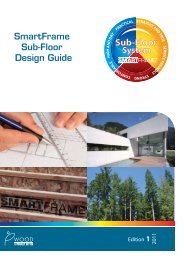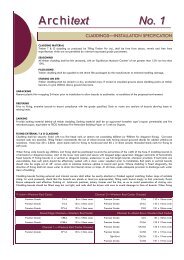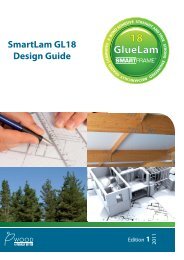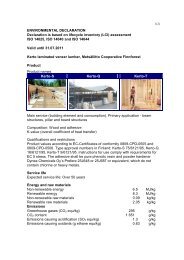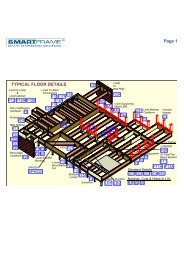SmartJoist Design Guide 2011.pub - Tilling Timber
SmartJoist Design Guide 2011.pub - Tilling Timber
SmartJoist Design Guide 2011.pub - Tilling Timber
Create successful ePaper yourself
Turn your PDF publications into a flip-book with our unique Google optimized e-Paper software.
DURABILITY AND EXPOSURE TO MOISTURE<br />
<strong>SmartJoist</strong>s are manufactured with Douglas Fir (Oregon)<br />
flanges with OSB webs, both having a durability rating of<br />
class 4, which is the same rating as some Ash type Eucalypts.<br />
Untreated <strong>SmartJoist</strong>s should not be used where<br />
the equilibrium moisture content is likely to remain above<br />
18 % for an extended period.<br />
Untreated <strong>SmartJoist</strong>s are suitable in the internal, fully<br />
protected, ventilated and the external above ground, protected<br />
zones of the structure as shown in appendix B of<br />
AS 1684. Untreated <strong>SmartJoist</strong> is not suitable for external<br />
above ground, exposed or humid indoor conditions,<br />
such as swimming pool enclosures.<br />
The wood fibre in <strong>SmartJoist</strong>s, like all wood products, is<br />
hygroscopic, which means it has an affinity for water. The<br />
wood fibre in <strong>SmartJoist</strong> will readily take up and release<br />
moisture in response to changes in the local environment.<br />
Moisture exposure will lead to dimensional change. While<br />
the products will withstand normal exposure, excessive<br />
exposure during distribution, storage or construction may<br />
lead to dimensional changes that affect serviceability. These<br />
changes include twisting, bowing or expansion to dimensions<br />
to beyond the specified tolerance of the product in<br />
the “as-manufactured” condition.<br />
As an organic material, mold and mildew may grow on<br />
untreated wood products if moisture is present. Prolonged<br />
periods of high moisture may also support the growth of<br />
wood decay fungi, which is another reason to follow proper<br />
methods of storage and handling of <strong>SmartJoist</strong>s.<br />
The table below shows the moisture content of<br />
<strong>SmartJoist</strong>s as a function of humidity.<br />
Moisture content of wood products % (1)<br />
MOISTURE EFFECTS ON<br />
<strong>SmartJoist</strong>s<br />
<strong>SmartJoist</strong> is supplied WITHOUT any short term construction<br />
sealer, but once framed into a structure may<br />
be exposed to the weather for a limited time (not greater<br />
than 3 months) without negative affect, BUT, it may<br />
exhibit some effects of this exposure.<br />
Relative Humidity % LVL Flange MC OSB web<br />
10 1.2 0.8<br />
20 2.8 1.0<br />
30 4.6 2.0<br />
40 5.8 3.6<br />
50 7.0 5.2<br />
60 8.4 6.3<br />
70 11.1 8.9<br />
80 15.3 13.1<br />
90 19.4 17.2<br />
(1). Approximate moisture content at 21 0 C<br />
Wetting during construction may lead to temporary elevated<br />
moisture content and dimensional changes. Once covered,<br />
the <strong>SmartJoist</strong>s will ultimately dry and re-equilibrate<br />
to the ambient humidity conditions, but some expansion or<br />
swelling may remain after drying.<br />
<strong>SmartJoist</strong>s - GENERAL NOTES<br />
Do NOT start toe nail<br />
into the corner of the flange<br />
or the top of the flange.<br />
MAXIMUM Nail diameter 3.15 mm<br />
<br />
<br />
Nails should be as far<br />
as practical from the<br />
end of the joist<br />
Start toe nail<br />
approximately 2/3<br />
up the side of the flange.<br />
1. Except where otherwise noted, 30 mm minimum bearing<br />
is required at joist ends and 42 mm minimum bearing<br />
is required at intermediate supports.<br />
2. Nail joists at each bearing with 2 of 3.15 Ф x 65 nails,<br />
using one each side placed 30 mm from the end to<br />
avoid splitting.<br />
3. <strong>SmartJoist</strong> blocking or SmartRim - face nail to bearing<br />
plate with 3.15 Ф x 65 nails at 150 mm centres. Nail<br />
rim joist to the end of the top and bottom flange of each<br />
<strong>SmartJoist</strong> with 1 3.15 Ф x 65 nail, use 1 3.75 Ф x<br />
75 nail top and bottom with joists with 58, 70 or 90<br />
<strong>SmartJoist</strong> <strong>Design</strong> <strong>Guide</strong> 7<br />
mm wide flanges.<br />
4. 19 mm SmartRim - toe nail to bearing plate with 3.15<br />
Ф x 65 nails at 150 centres or 4.5 Ф x 75 nails at 300<br />
centres. Nail rim to the end of the top and bottom<br />
flanges of each <strong>SmartJoist</strong> with 1 3.15 Ф x 65 nails.<br />
5. Sheathing nailing to top flange (Joists must be fully<br />
braced before sheathing is nailed)<br />
- Space 2.8 Ф x 65 and 3.15 Ф x 65 nails no closer<br />
than 50 mm per row.<br />
- Space 3.75 x 75 nails no closer than 75 mm.<br />
Maximum nail spacing: 300 mm



